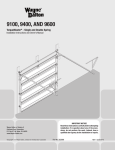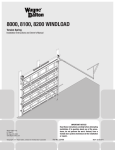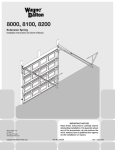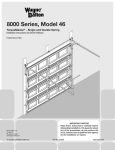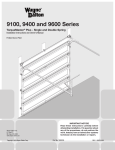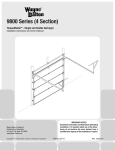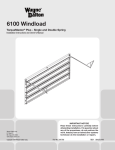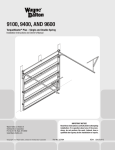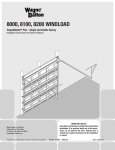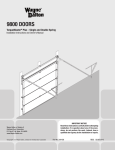Download Wayne-Dalton 5500 Garage Door Opener User Manual
Transcript
START HERE 5500/9700 Estate - Standard Lift - TorqueMaster II™ IMPORTANT! TITLED “REMOVING THE OLD DOOR/PREPARING THE OPENING”. IF THE INSERT SHEET INSTRUCTIONS ARE NOT INCLUDED, CONTACT WAYNE-DALTON CORP. FOR A FREE COPY. If removing an existing door, carefully follow the directions given on the insert sheet instruction in the portion titled “Removing the Old Door”. WARNING! REMOVAL OF AN EXISTING DOOR CAN BE DANGEROUS. FOLLOW INSERT Q.I. flagangle: Put the lower Twistlock tab on the flagangle into the Twistlock hole in the vertical track. Give the flagangle 1/4 turn to lock in place. Repeat for other side. Fully adjustable flagangle: Secure the vertical to the lower slot in the flagangle using (1) stud plate and (2) 1/4” -20 flange hex nuts. Repeat for other side. To install horizontal track, place the curved end over the top roller. Align the bottom of the horizontal track with the top of the vertical track. Q.I. flagangle: Align the key slot in each horizontal track with the quick install tabs on the corresponding flagangle. Push the curved portion of the horizontal downward to lock into place. Fully adjustable flagangle : Secure each horizontal track to the corresponding flagangle with (1) stud plate and (2) 1/4”-20 flanged hex nuts. NOTE: On some adjustable flagangles, each horizontal track is secured to the corresponding flagangle with (2) 1/4”-20 track bolts and nuts. Installation Instructions Layout 9A d 11A c SHEET INSTRUCTIONS CAREFULLY, OTHERWISE SEVERE OR FATAL INJURY COULD RESULT. Begin the installation of the door by checking the opening. It must be the same size as the door. Vertical jambs must be plumb and the header level. Side clearance, from edge of door to wall, must be minimum of 3-1/2” (89 mm) on each side. Follow the steps below. The steps correspond to the illustrations on the garage door layout. IMPORTANT! Stainless steel or PT2000 Coated lag screws MUST be used when installing center bearing brackets, end bearing brackets, jamb brackets, operator mounting/support brackets and disconnect brackets on treated lumber (preservative-treated). Stainless steel lag screws are NOT necessary when installing products on un-treated lumber. NOTE: It is recommended that 5/16” x 1-5/8” lag screws be pilot drilled using a 3/16” drill bit, and 1/4” x 2” lag screws and 1/4” x 1-1/2” lag screws be pilot drilled using a 1/8” drill bit, prior to fastening. For proper opening preparation refer to the portion of the insert sheet instructions titled “Preparing the Opening”. IMPORTANT! It is recommended that doors 12’ 0” wide and over be installed by two person, to avoid possible injury. 1 11 HORIZONTAL ANGLE a 12A b d b Fully adjustable track a vertical track 9B c Level horizontal track and bolt the horizontal angle to the slot in the flagangle using (1) 3/8”-16 x 3/4” truss head bolt and nut. Repeat for other side. Remove the nail that was temporarily holding the top section in place. IMPORTANT! Failure to remove nail before attempting to raise door could cause permanent damage to top section. k FLAG ANGLE f 14A 13A 10A With horizontal tracks installed, you can now adjust the top brackets. Vertically align the top section with the lower sections. Once aligned, position top roller in the adjustable slide, out against the horizontal track. Maintaining the slide’s position, tighten the nuts to secure the slide to the top bracket. Repeat for other side. NOTE: If you installed A-frame bracket you will need to lock the top slide into place on the bracket using a 1/4-20 x 11/16” self-drilling screw into the slide to lock the slide in place (see 11B). 12B 11B 1-11/16” (43mm) to 1-3/4” (44mm) g LEFT HAND DRUM 21 a 13B RIGHT HAND DRUM 13C SELFDRILLING SCREW 14B 15 12 g 3 f Measure the length of the vertical tracks. Using the Quick Install Jamb Bracket Schedule (shown on reverse side), determine the placement of the jamb brackets for your door height. Align the Twistlock wings on each jamb bracket with the correct butterfly hole in the track and turn the jamb bracket perpendicular to the track so the mounting flange is toward the back leg of the track. Set tracks aside. g DOOR-WIDTH PLUS 3-3/8” (86 mm) TO 3-1/2” (89 mm) 1 flag ANGLE k 4 NOTE: The stutting schedule below is for reference only, all struts are pre-installed at the factory. twistlock hole DOOR WIDTH QUANTITY 5 6’ 0” TO 10’ 11” 11’ 0” TO 14’ 2” 14’ 3” TO 16’ 2” 16’ 3” TO 18’ 0” 0 1 2 3 TOP OF TOP TOP OF LOCK SECTION SECTION N/A X X X N/A N/A N/A X TOP OF BOTTOM SECTION N/A N/A X X TorqueMaster™ drums are marked right and left. Make sure you place the cable from the right hand drum on the right hand milford pin, and left hand drum on the left hand milford pin. Uncoil the counterbalance cables and slip the loop at the ends of the cables over the milford pins on the bottom section. Insert a roller in the bottom bracket of the bottom section and insert another roller at #1 end hinge at the top of the bottom section, Fig. 5 and 8A. Repeat for right side. NOTE: Bottom section can be identified by a #1 end hinge, the factory attached bottom astragal, or by the bottom bracket warning labels on each endstile. NOTE: Verify that astragal does not protrude more than 1/2” past ends of the bottom section. If excess needs to be trimmed off, be careful not to stretch astragal, or it may end up shorter than section width. IMPORTANT! Right and left hand is always determined from inside the building looking out. 13 a STRUTTING SCHEDULE q.i. track fully adjustable track 17A twistlock tab 2C 2B g 2A a 16B 17B 7A 10B CABLE 16A 7 h 30” TO 36” SPACING f 5/8”(16MM) i 3 20 72” (1829 mm) i 8C f f Locate the spring pad. The spring pad is a vertical running board directly above the center of the door. Remove (2) 1/4”-20 flange nuts from bottom of opener power head. NOTE: Do not discard flange nuts. Place the support bracket underneath opener power head, to the right side of motor, centered on spring pad. Level the torque tube to the top of the door section with the idrive™ resting on the support bracket. Once torque tube is level, secure support bracket to the spring pad with (2) 1/4” x 2” lag screws. Lift and slide the opener power head over the support bracket, aligning the mounting studs with the bracket slots. Loosely fasten to mounting studs with the (2) 1/4”20 flange nuts. NOTE: Do not tighten 1/4”-20 flange nuts to power head studs at this time. 19 18 HINGE TUBE MILFORD PIN LEFT HAND BOTTOM BRACKET 7B g set screw 9 CANOE CLIP NOTE: 16’ - 18’ Doors will use A-shaped bracket. The rest of the doors will use the L-shaped brackets L-shaped bracket: To install the L-shaped top brackets, align the top holes in the top bracket base with the second set of holes in the endcap as shown in Fig. 9. Fasten using (4) 1/4”-14 x 5/8” self tapping screws. Secure the top slide to the bracket using (2) 1/4”-20 x 5/8” carriage bolts and (2) 1/4”-20 flanged hex nuts. Repeat for other side. 10 16 f IMPORTANT! For larger size doors, double end hinges are already pre-installed to the section(s). Place top section in the door opening and secure it temporarily by driving a nail into the header near the center of the door and bending it over the section. Insert rollers into top slides. Now fasten the hinges to the top section, Fig. 8A thru 8C. When installing a door with a TorqueMaster™ counterbalance system, vertical track alignment is critical. Position flagangle between 1-11/16” (43 mm) to 1-3/4” (44 mm) from the edge of the door. Flagangles must be parallel to the door section ends. Now complete the vertical track installation on both sides by securing the center jamb brackets and tightening the other 5/16” x 1-5/8” lag screws, Fig. 10. IMPORTANT! The dimension between the flagangles must be door-width plus 3-3/8” (86mm) to 3-1/2” (89 mm) for smooth, safe door operation. 15 Beginning with the right side, install the counter gear with the missing tooth toward the outside, away from the end bracket. Press the counter gear onto the end bracket until snaps engage. Select the right hand counter cover assembly and align the hex of the counter cam with the end of the winding shaft. Also, align the “0” on the counter cover with the raised rib on the end bracket. Press the counter cover assembly against the counter gear until it locks into place. Repeat for left hand side for double spring applications. NOTE: No drive gear, counter gear or counter cover assembly is required on left hand side for single spring applications. Only an end bracket is needed. IMPORTANT! At this time do not wind counter balance springs! f 4 NOTE: The lock section can be identified by a #3 end hinge for 7’ high 3 section doors, and by the yellow and black warning label attached to the right side of the section. Insert rollers into both end stiles of the lock section, Fig. 8A. With assistance lift section and place rollers over the tops of the vertical tracks. Install by guiding rollers into the vertical track on both sides and gently lowering the section onto the bottom section. Vertically align the mark near the center (on back) of the door, or vertically align the center stiles on the face (on front) of the door. Rotate the hinge leaf upward and fasten the hinge to the above section with (2) 1/4”-14 x 5/8” self tapping screws, Fig. 8A. A-frame bracket: To install the A-frame top brackets, place the top of bracket flush with bottom of the strut, even with the edge of the endcap. Fasten using (4) 1/4”-14 x 5/8” self tapping screws. Secure the top slide to the bracket using (1) 1/4”-20 x 5/8” carriage bolt and (1) 1/4”-20 flanged hex nut. Repeat for other side. 17D h g 5 17C j Position the left hand vertical track over the rollers of the bottom section. NOTE: Make sure the counterbalance cable is located between the rollers and the door jamb. Secure jamb brackets and flagangles to the jamb using 5/16” x 1-5/8” lag screws. Install the right hand vertical track the same way. Hang cables over flagangles. IMPORTANT! The tops of the vertical tracks must be level from side to side. If the bottom section was shimmed to level it, then the vertical track on the shimmed side, must be raised the height of the shim. The center hinges are installed by rotating the hinge leaf upward and secure the hinge to the above section with (3) 1/4”-14 x 5/8” self tapping screws, Fig. 8C. IMPORTANT! Push and hold both hinge leafs up against the section while securing with 1/4”-14x 5/8” self tapping screws. Do not install the top section at this time. Beginning with the right hand side, lubricate entire circumference of the drive gear with the oil provided in the packet. DO NOT SUBSTITUTE OIL. Slide the drive gear onto the winding splines until it touches the flagangles. NOTE: No drive gear is required for the left side on single spring applications. IMPORTANT! Warning tags must be securely attached to both end brackets. Slide the right hand end bracket over the drive gear. Secure end bracket and the flagangle to the jamb using (2) 5/16” x 1-5/8” lag screws. 7C Before installing the bottom section, measure and cut vinyl jamb weather-stripping (may not be included) for entire garage door opening. Temporarily nail the weather-stripping to the door jambs and header approximately 12” to 18” apart. Center the bottom section in the door opening. Level it using wooden shims under the bottom astragal, if necessary. Double end hinges are installed by rotating both hinge leafs upward and secure the hinges to the above section with (6) 1/4”-14 x 5/8” self tapping screws, Fig. 8B. Shake the torque tube gently to extend the winding shafts out about 5” on each side. For single spring applications, there will be no left hand winding shaft in the torque tube. Lift the torque tube and rest it on top of flagangles. Orient torque tube so that back of opener is flat against header/spring pad. Cable drums and torque tube are cam shaped to fit together only one way. To install the cable drum, slide the drum over the winding shaft until the drum seats against the torque tube. The winding shaft must extend past the drum far enough to expose the splines and the groove. Align the winding shaft groove with the round notch in the flagangle. Repeat for opposite side for double spring applications. For single spring applications, insert the left hand loose winding shaft into the left hand drum prior to sliding the drum over the torque tube. NOTE: On single spring applications, take care in handling the loose winding shaft (left side) so that it does not slide back into the torque tube. 14 6 8 idrive™ Installation NOTE: For non-idrive™ operated garage doors see Alternate Installations on the reverse side of this manual. Lay the torque tube on the floor (inside garage) in front of the door with the labeled end to the left. NOTE: Opener will not slide over a torque tube label. Attempting to slide opener over the left end of the torque tube can damage the internal electronics. NOTE: Hold opener by the main body. Do NOT hold by the motor. Look into the opener’s left side to ensure the left hand bearing and the internal (black) sleeve are aligned with the torque tube profile. Once aligned, slide the opener power head onto the right hand end of the torque tube. As the right end of the torque tube enters the internal (black) sleeve, rotate the opener back and forth slightly to help aid alignment. NOTE: Do not force the opener onto the torque tube if misalignment occurs. Continue sliding the opener power head onto the torque tube. Align the right hand bearing with the torque tube and slide the opener power head completely onto the torque tube until the torque tube exits the opener power head’s right hand bearing. Continue sliding the opener power head to the center of the torque tube and plug the motor power cord into the opener power head. IMPORTANT! Right and left hand is always determined from inside the garage looking out. 2 Using a hammer, tap the horizontal angle towards the curved end of the track until the hole in track and angle are aligned. Set tracks aside. WARNING! DO NOT RAISE DOOR UNTIL HORIZONTAL TRACKS ARE SECURED AT REAR, AS OUTLINED IN STEP 21, OR DOOR COULD FALL FROM OVERHEAD POSITION CAUSING SEVERE OR FATAL INJURY. ASTRAGAL 8B 6A 6B 8A f f HINGE LEAF f HINGE LEAF 17 Attach the loose disconnect cable (located in operator hardware bag) to the opener power head with “S” hook. Close both ends of “S” hook to lock assembly together. Thread the disconnect cable through hole in right hand end bracket and remove all slack between power head and right hand end bracket. Mark location on right door jamb, six feet above the ground to mount disconnect handle. Thread disconnect cable through handle bracket and then handle. Align top of handle bracket with mark on wall. Remove all cable slack between the power head and top of handle bracket. Insert and tighten #6-20 x 1/2” screw until snug, and then tighten screw 1 to 1-1/2 additional turns to secure cable in handle. Trim off excess cable from bottom of handle. Holding handle bracket, remove all remaining slack between power head. With slack removed, secure bottom of handle bracket with (1) 1/4” x 1-1/2” lag screw. CAUTION: Pull handle just enough to remove the cable slack. Pulling the cable more could cause the opener power head to disconnect from the torque tube. Rotate disconnect handle to one side exposing upper mounting hole in handle bracket. Secure handle bracket with a second 1/4” x 1-1/2” lag screw. Apply emergency disconnect label next to the mounted bracket. Use mechanical fasteners if adhesive will not adhere. Using the emergency disconnect, pull disconnect handle downwards and place it in the manual door operated position. Use disconnect label for reference. Motor will be rotated 90° from its packaged position. NOTE: If motor does not pivot 90°, see troubleshooting section in the idrive™ main installation manual. 18 HINGE LEAF Clamp locking pliers onto both vertical tracks just above third roller. This is to prevent garage door from rising while winding counterbalance springs. 6C WARNING! LEFT HINGE SHOWN, RIGHT HINGE SYMMETRICALLY OPPOSITE LEFT HINGE SHOWN, RIGHT HINGE SYMMETRICALLY OPPOSITE FAILURE TO CLAMP TRACK CAN ALLOW DOOR TO RAISE AND CAUSE SEVERE OR FATAL INJURY. Adjust the counter balance cables by rotating the drum until the set screw faces directly away from the header. IMPORTANT! Do NOT double wrap counterbalance cables on TorqueMaster drums. Loosen the set screw no more than 1/2 turn. Pull on the end of the cable to remove all cable slack. Check to ensure the cable is aligned and seated in the first groove of the cable drum. Snug the set screw, then tighten an additional 1-1/2 turns. Cut off excess cable. CONTINUE INSTALLATION INSTRUCTIONS ON REVERSE SIDE. 1/4” x 2” Slotted Hex Head Lag Screw #315760 k Stud Plate #266102 9. Door is constantly under EXTREME SPRING TENSION. To prevent possible severe or fatal injury, removal, installation, adjustments or repairs, ESPECIALLY to SPRING ASSEMBLIES, CENTER ANCHOR BRACKETS, BRACKET BOLTS, CABLE DRUMS, BOTTOM CORNER BRACKETS, SHEAVES, CABLES, ETC., should ONLY be performed by qualified door service people. 10. Check all bolted connections monthly during the lifetime of the door to prevent damage or severe/ fatal injury caused by loose connections. x 1-1/2” Slotted Hex Head h 1/4” Lag Screw #315759 j 11. It is recommended that doors 12’ 0” wide and over be installed by two person, to avoid possible injury. 12. Definition of key words used in this manual: #6-20 x 1/2” Plastifast (Disconnect Handle) #296940 WARNING! — Indicates a potentially hazardous situation which, if not avoided, could result in severe or fatal injury. IMPORTANT! — Required step for safe and proper door operation. NOTE: — Information assuring proper installation of the door. © Copyright 2004 Wayne-Dalton Corp. ...CONTINUED INSTALLATION INSTRUCTIONS 19 WARNING! Prior to winding or making adjustments to the springs, ensure you’re winding in the proper direction as stated in the Installation Instructions. Otherwise the spring fittings may release from spring if not wound in the proper direction and could result in severe or fatal injury. IMPORTANT! DO NOT USE IMPACT GUN TO WIND SPRING(S) Beginning with the right hand side. Press and hold in the canoe clip. Ensure the cable is in the first groove of the drum. Using an electric drill (high torque gear reduced to 1300 RPM preferred) with a 7/16” socket, carefully rotate right hand winding bolt clockwise, until counter shows 2-3 turns. This will keep the counterbalance cable taut while adjusting the left hand side counterbalance cable. Repeat step 18 and 19 for left side. NOTE: Single spring applications require no spring winding on the left hand side. Ensure counterbalance cable tension is equal for both sides prior to fully winding spring(s) to appropriately 15 1/2 turns for solid sections, or 15 turns for glazed top sections. Carefully rotate the winding bolt head clockwise until the counter shows the correct number of turns for your door. Repeat for the opposite side on double spring TorqueMaster™ systems. If door raises off the floor remove 1/2 - 1 full turn from each spring before proceeding. After spring is wound, hold the lock nut (in back of end bracket) stationary with a 7/16” wrench while rotating the winding bolt clockwise until snug. Tightening of the lock nut prevents spring from unwinding. Repeat for opposite side if necessary. IMPORTANT! Adjustments to the recommended number of turns may be required. AFTER REAR SUPPORT ASSEMBLY IS COMPLETE, check door balance. If door raises off the floor under spring tension alone, then reduce turns until door will rest on floor. A “hot” door such as this can cause idrive™ operation problems. 20 Drum wraps are identified as right and left. To install, place the drum wrap over the cable drum and under the idrive™ disconnect cable (if installed). Align the outside flange over the outside edge of the cable drum and push the drum wrap down onto the cable drum. 21 Hold the door down to prevent it from rising unexpectedly in the event the spring(s) was overwound and carefully remove the locking pliers from the vertical tracks. Raise the door until the top section and half of the next section are in a horizontal position. Do not raise door any further since rear of horizontal track is not yet supported. WARNING! RAISING DOOR FURTHER CAN RESULT IN DOOR FALLING AND CAUSING SEVERE OR FATAL INJURY. Now clamp a pair of locking pliers to the vertical tracks just above the second roller on one side, and just below the second roller on the other side. This will prevent the door from raising or lowering while installing the rear support. Using perforated angle, 2” lag screws and 5/16” bolts with nuts (may not be supplied), fabricate rear support for horizontal tracks. Attach horizontal tracks to the rear supports with 5/16”-18 x 1-1/4” hex bolts and nuts (may not be supplied). Horizontal tracks must be level and parallel with door. WARNING! KEEP HORIZONTAL TRACK PARALLEL AND WITHIN 3/4” OF DOOR EDGE, OTHERWISE DOOR COULD FALL, RESULTING IN SEVERE OR FATAL INJURY. Permanently attach the vinyl weather stripping to both door jambs and the header, Fig. 5C. Now, lift the door and check it’s balance. Adjust, if door lifts by itself (also hard to pull down) or if door is difficult to lift (too easy to pull down). Anytime spring adjustments are made you must loosen the lock nuts to begin with and retighten both lock nuts afterwards. To adjust spring(s), only add or remove 1/4 turn on the counter reading at a time. Adjust both sides equally. IMPORTANT! Do not add or remove more than 1 spring turn from specified amount. If the door still does not operate easily, lower the door into the closed position, UNWIND SPRING(S) TO ZERO, and recheck the following items: 1.) Check the door for level. 2.) Check the TorqueMaster™ tube and flagangles for level and plumb. 3.) Check the distance between the flagangles - must be door width plus 3-3/8” to 3-1/2”. 4.) Check the counterbalance cables for equal tension - loosen set screws and adjust if necessary. 5.) Rewind the spring(s). 6.) Make sure door isn’t rubbing on jambs. NOTE: As a safety feature, the right hand end bracket on single spring applications, both right hand and left hand end brackets double springs applications, cannot be disassembled for service until the spring(s) is completely unwound and the counter cover reads zero. After door installation is completed, refer to the idrive™ owner’s manual, starting at the PRE-OPERATION INSTALLATION section to complete the opener installation. 22 If there are stiles or lite frame dividers included with your door, install them per their instructions at this time. ALTERNATE INSTALLATIONS 12A 12A If you are not installing the idrive™ operator on your garage door, you must install the center bracket bushing assembly. Follow these instructions for a non-idrive™ operated garage doors. TorqueMaster™ springs come lubricated and pre-assembled inside the torque tube. To install, lay the torque tube on the floor in front of the door with the labeled end to the left. Slide the center bracket/bushing assembly onto the torque tube, from the right hand side, toward the center. Shake the TorqueMaster™ tube gently to extend the winding shafts out about 5” on both ends. Single spring TorqueMaster will only have the right hand spring. Slide center bracket bushing assembly from the right side to the center of the torque tube. IMPORTANT! Right and left hand is always determined from inside the building looking out. 12B 12B If you are installing an electric operator on your door, the following information is provided to ensure proper function of your door/operator installation. Figure below shows a typical means of connecting the operator arm to the operator stile located in the center of the top section. 16 16 To locate the center bracket, mark the header halfway between the flagangles and level the TorqueMaster tube. Fasten the metal bracket to the header using (2) 1/4” x 1-1/2” lag screws. STEP PLATES TYPICAL OPERATOR ARM (SUPPLIED WITH OPERATOR) OPTIONAL ACCESSORY INSTALLATIONS (OUTSIDE) Raise the door to a comfortable working height and secure with locking pliers to the track. Locate the center stile on the bottom section of the door. Using the pre-punched holes at the bottom of the stile as a template, drill (2) 7/32” (6mm) dia. holes through the section. Using the previously drilled holes as a guide, enlarge the holes from outside the door to 7/16” (11mm) dia. and assemble the outside and inside step plates to the section using (2) #8 x 1-5/8” screws. NOTE: Do not drill through or enlarge holes on the inside of the door. (INSIDE) DRILL THROUGH SECTION WITH A 7/16” (11mm) DIA. DRILL BIT (2) #8 x 1-5/8” SCREWS WARNING! To avoid serious injury to fingers or hands, never place fingers or hands between door sections and track when operating door. Always use step plate when manually operating door. No.6 screw eye PULL ROPE Attach No. 6 screw eye to wood jamb approximately 48” - 50” (1220 - 1270 mm) off the floor. Use (1) 1/4”-14 x 5/8” selftapping screw to fasten pull rope clip to the end stile and then tie the pull rope to both the screw eye and the pull rope clip. ERATORS. CHILDREN MAY BECOME ENTANGLED IN THE ROPE RESULTING SEVERE OR FATAL INJURY. INSIDE SIDE LOCK f 2” STRUT f f (STRUTS ONLY) e Select desired side of door for lock placement. Locate the striker plates over the pre-punched holes in the vertical track on the selected side, nearest the center of the lock(second) section. Fasten the stiker plate to the vertical track using (2) 1/4”-20 x 9/16” track bolts and flanged hex nuts. The side lock should be spaced in approximately 1/8” from the edge of the section. Ensure that the lock is square with the section and the lock bolt aligns with the striker plate. Secure the lock to the end stile with (4) 1/4”-20x11/16” self-drilling screws. IMPORTANT! Side locks must be removed or made inoperative in the unlocked position if an operator is installed on the door. SEE OPERATOR BRACKET INSTRUCTIONS FOR DETAILS ON INSTALLATION Installation Tips: 1. Follow the installation instructions supplied with your operator. 2. Reinforce top section prior to attaching operator. 3. Install trolley rail 1/2” to 1” (13 - 25 mm) above high arc of top section of the door. 4. Mount operator to ceiling so that 1” to 1-1/2” (25 - 38 mm) clearance is maintained between trolley rail and top section when door is fully open (trolley rail will slope down towards rear). 5. The operator bracket must be mounted to the operator muntin on the top section. 6. Attach operator rail securely to spring pad. 7. Attach operator to ceiling using perforated angle. 8. IMPORTANT! ANGLE MUST BE ATTACHED TO FRAMING MEMBER(S) WARNING! OPERATOR MUST BE TESTED AT TIME OF INSTAL- WARNING! DO NOT INSTALL PULL ROPE ON DOORS WITH ELECTRIC OP- rope TRACK END STILE (2) 1/4”-20x9/16” TRACK BOLTS (4) 1/4”-20x11/16” SELF DRILLING SCREWS LATION AND MONTHLY THERE AFTER, ACCORDING TO THE MANUFACTURER’S INSTRUCTIONS TO ENSURE THAT ALL SAFETY FEATURES ARE FUNCTIONING CORRECTLY. FAILURE TO PERFORM THESE TESTS AND MAKE ANY NECESSARY ADJUSTMENTS/REPAIRS CAN RESULT IN SEVERE OR FATAL INJURY. 8 6 STRIKER PLATE SLIDE 3 SIDE LOCK 4 7 OPERATOR BRACKET Locate the center of the top section’s strut. The strut is factory attached with ¼” – 14 x 5/8” self tapping screws. Remove, but retain, a few of these screws (approximately 4-6 from the center of the strut, allowing the operator bracket to slide between the section and the strut. Slide the operator bracket until it seats on the male part of the section. The operator bracket must be centered and positioned on the top section so it bridges the transition point of the section thickness. Attach the operator bracket using (8) ¼” – 14 x 5/8” self tapping screws as shown. Re-attach the strut using (2) ¼” – 20 x 11/16” self drilling screws through the operator bracket. Finish re-attaching the strut using the self tapping screws removed previously. 5 2 5500/9700 ESTATE™ TorqueMaster™ with idrive™ LIFETIME LIMITED WARRANTY TYPICAL TROLLEY OPERATOR INSTALLATION When installing a DoorMaster™ operator replace the bushing with the drive gear (located in DoorMaster™ package). 5500/9700 Estate Standard Lift TorqueMaster™ - Single Spring and Double Spring 1/4”-14 x 5/8” Self Tapping Screw #236565 i Installation Instructions and Owners Manual f 5/16” x 1-5/8” Hex Head Lag Screw #314937 P 3/8”-16 x 3/4” Truss Head Bolt #154531 g PAINTING Note: It is NOT recommend that you paint your door any dark color, this may lead to higher surface temperatures resulting in gaps between the stiles and rails of your door section(s). After the surface has been properly prepared it must be allowed to dry thoroughly, then coated immediately with a premium quality latex house paint. Follow the paint label directions explicitly. Oil base, or solvent base paints are not recommended. Please note that if substrate is exposed and not properly primed, painting with latex paint may cause accelerated rusting of the steel in the exposed area. NOTES: 1. Repainting of finish painted steel doors cannot be warranted, as this condition is totally beyond the door manufacturer’s control. 2. If the finish painted steel door surface has a textured surface representing wood grain, stucco, etc., this step should not be attempted as danger of exposing substrate is greatly increased. 3. Consult a professional coatings contractor if in doubt about any of the above directions. 4. Follow directions explicitly on the paint container labels for proper applications of coatings and disposal of containers. Pay particular attention to acceptable weather and temperature conditions in which to paint. DÉCOR LITES ACRYLIC GLAZING CLEANING INSTRUCTIONS: 1. Clean acrylic glazing with nonabrasive soap or detergent and plenty of water. Use your bare hands to feel and dislodge any caked on particles A soft, grit-free cloth, sponge or chamois may be used to wipe the surface. Do not use hard or rough cloths that will scratch the acrylic glazing. Dry glazing with a clean damp chamois. 2. Kerosene may be used to remove grease and oil. When using kerosene for cleaning purposes, make sure that you are familiar with it’s properties, using it only in a well ventilated area away from any sources of sparks and/or fire. 3. DO NOT USE: Window cleaning fluids, scouring compounds, gritty cloths, gasoline, or solvents such as alcohol, acetone, carbon tetrachloride, etc. © Copyright 2004 Wayne-Dalton Corp. TOP SECTION MUST BE REINFORCED Wayne-Dalton Corp. P.O. Box 67, Mt. Hope, Ohio 44660 www.wayne-dalton.com Subject to the terms and conditions contained in this Lifetime Limited Warranty, Wayne-Dalton Corp. (“Manufacturer”) warrants the sections of the door, which is described at the top of this page, for as long as you own the door against: (i) Peeling, cracking, or chalking of the original factory-applied coating on the door as a result of a defect in the original factory-applied coating or in the application of the original factory-applied coating, in cases where the door sections and the original factory-applied coating: (a) have not been subjected to adverse atmospheric conditions or contaminates (such as salt water or other marine environment, or to toxic or abrasive substances, including those in the air); (b) have been maintained in compliance with Manufacturer’s recommendations; and (c) have not been subject to physical abrasion, impacted by a hard object, or have been punctured. (ii) The door becoming inoperable due to rust-through of the steel skin from the core of the door section, caused by cracking, splitting, or other deterioration of the steel skin, or due to structural failure caused by separation or degradation of the foam insulation. The Manufacturer warrants the garage door hardware (except springs) and the tracks of the above-described door, for as long as you own the door, against defects in material and workmanship, subject to all the terms and conditions below. The Manufacturer warrants those component parts of the door not covered by the preceding provisions of this Lifetime Limited Warranty against defects in material and workmanship for a period of ONE (1) YEAR from the date of installation. The Manufacturer warrants the factory-applied finish and the factory attached stiles against fading and cosmetic changes from the time of installation for TWO (2) YEARS. The factory attached stiles are warranted against peeling, cracking, chalking, or delamination from the time of installation for TWO (2) YEARS. If the door is re-stained or re-painted, the TWO (2) YEARS warranty for the factory-applied finish is void. After a period of TWENTY (20) YEARS, from time of installation, replacement of Lifetime Limited Warranty materials will be prorated at 50 per cent of Manufacturer’s published list pricing at time of claim, and you must pay this amount. This Limited Warranty is extended only to the person who purchased the product and continues to own the premises (where the door is installed) as his/her primary residence (“Buyer”). This Limited Warranty does not apply to residences other than primary, or to commercial or industrial installations, or to installations on rental property (even when used by a tenant as a residence). This Limited Warranty is not transferable to any other person (even when the premises is sold), nor does it extend benefits to any other person. As a result this Limited Warranty does NOT apply to any person who purchases the product from someone other than an authorized Wayne-Dalton dealer or distributor. The Manufacturer will not be responsible for any damage attributable to improper storage, improper installation, or any alteration of the door or its components, abuse, damage from corrosive fumes or substances, salt spray or saltwater air, fire, Acts of God, failure to properly maintain the door, or attempt to use the door, its components or related products for other than its intended purpose and its customary usage. This Limited Warranty does not cover ordinary wear. This Limited Warranty will be voided if the original finish is painted over, unless Manufacturer’s preparation and painting instructions are followed explicitly. This Limited Warranty will be voided if any holes are drilled into the door, other than those specified by the Manufacturer. THIS LIMITED WARRANTY COVERS A CONSUMER PRODUCT AS DEFINED BY THE MAGNUSON-MOSS ACT. NO WARRANTIES, EXPRESS OR IMPLIED (INCLUDING BUT NOT LIMITED TO THE WARRANTY OF MERCHANTABILITY OR FITNESS FOR A PARTICULAR PURPOSE) WILL EXTEND BEYOND THE TIME PERIOD SET FORTH IN UNDERSCORED BOLD FACE TYPE IN THIS LIMITED WARRANTY, ABOVE. • Some States do not allow limitations on how long an implied warranty lasts, so the above limitations may not apply to you. Any claim under this Limited Warranty must be made in writing, within the applicable warranty period, to the dealer from which the product was purchased. Unless the dealer is no longer in business, a written claim to the Manufacturer will be the same as if no claim had been made at all. At the Manufacturer’s option, pursuant to the dealer having notified the Manufacturer of a warranty claim, a service representative may inspect the product on site, or Buyer may be required to return the product to the Manufacturer at Buyer’s expense. Buyer agrees to cooperate with any representative of the Manufacturer and to give such representative full access to the product with the claimed defect and full access to the location of its installation. If the Manufacturer determines that the claim is valid under the terms of this Limited Warranty, the Manufacturer will cause the defective product to be repaired or replaced. The decision about the manner in which the defect will be remedied will be at the discretion of the Manufacturer, subject to applicable law. THE REMEDY WILL COVER ONLY MATERIAL. THIS LIMITED WARRANTY DOES NOT COVER OTHER CHARGES, SUCH AS FIELD SERVICE LABOR FOR REMOVAL, INSTALLATION, PAINTING, SHIPPING, ETC. Any repairs or replacements arranged by Manufacturer will be covered by (and subject to) the terms, conditions, limitations and exceptions of this Limited Warranty; provided, however, that the installation date for the repaired or replaced product will be deemed to be the date the original product was installed, and this Limited Warranty will expire at the same time as if there had been no defect. If a claim under this Limited Warranty is resolved in a manner other than described in the immediately preceding paragraph, then neither this Limited Warranty nor any other warranty from the Manufacturer will cover the repaired or replaced portion of the product. THE REMEDIES FOR THE BUYER DESCRIBED IN THIS LIMITED WARRANTY ARE EXCLUSIVE and take the place of any other remedy. The liability of the Manufacturer, whether in contract or tort, under warranty, product liability, or otherwise, will not go beyond the Manufacturer’s obligation to repair or replace, at its option, as described above. THE MANUFACTURER WILL NOT UNDER ANY CIRCUMSTANCES BE LIABLE FOR SPECIAL, INCIDENTAL, OR CONSEQUENTIAL DAMAGES, including (but not limited to) damage or loss of other property or equipment, personal injury, loss of profits or revenues, business or service interruptions, cost of capital , cost of purchase or replacement of other goods, or claims of third parties for any of the foregoing. • Some States do not allow the exclusion or limitation of incidental or consequential damages, so the above limitation or exclusion may not apply to you. No employee, distributor, dealer, representative, or other person has the authority to modify any term or condition contained in this Limited Warranty or to grant any other warranty on behalf of or binding on the Manufacturer, and anyone’s attempt to do so will be null and void. Buyer should be prepared to verify the date of installation to the satisfaction of the Manufacturer. The rights and obligations of the Manufacturer and Buyer under this Limited Warranty will be governed by the laws of the State of Ohio, USA, to the extent permitted by law. • This Limited Warranty gives you specific legal rights and you may also have other rights, which may vary from State to State. © Copyright 2009 Wayne-Dalton Corporation U 1/4”-20 x 11/16” Self Drilling Screw #300723 8. To prevent severe or fatal injury, avoid standing in the open doorway or walking through the doorway while the door is moving. W d e 7. DO NOT PERMIT children to play with the garage door or the electrical controls. Severe or fatal injury could result, should the child become entrapped between the door and the floor. K 3/8”-16 Hex Nut #100313 1/4”-20 x 5/8” Carriage Bolt #306657 Saw Horses For Supporting Sections During Assemblies T b c 1/4”-20 Flanged Hex Nut #100279 (2) Locking Pliers www.wayne-dalton.com a (1) Tape Measure V NOTE: Jamb brackets are stamped for identification. R 6. Should the door become hard to operate or completely inoperative, a qualified door agency should correct the problem to prevent damage to the door or serious personal injury. (1) Pliers L 5. Operate door ONLY when properly adjusted and free of obstructions. O (1) Hammer M Safety Glasses (1) 7/16” Wrench Q 1ST SET 4. If the door is to be electrically operated at any time, all pull ropes MUST be removed to prevent severe or fatal injury to children who may become entangled in the rope. Any locking mechanism MUST be removed or made inoperative in the unlocked position.. N QIJB-3 (1) Level (2’ Minimum Length) QIJB-5 SURFACE PREPARATION FOR PAINTING Wax on the surface must be removed or paint peeling/flaking will result. To remove this wax, it will be necessary to lightly scuff the surface with a fine steel wool pad, saturated with soapy water. A final wipe and rinse should be done with clean water only, to remove any loose particles and any soapy film residue. Surface scratches, which have not exposed the metal substrate, can be lightly buffed or sanded with 0000 steel wool or No. 400 sand paper to create a smoother surface. Care must be taken to not expose the substrate under the paint (see Note No. 2). Once the substrate is exposed, the likelihood for rusting is greatly increased. See the following paragraph if metal substrate is observed. The exposed substrate must be treated to prevent rust from forming (see Note No. 2). Sand the exposed area lightly and paint with a high quality metal primer, specifically intended for galvanized surfaces, to protect the area from corrosion. Follow drying time on primer can label before applying topcoat. The surface of the factory-applied finish, that is being painted, must not be too smooth, or the paint will not adhere to it (see Note No. 2). It is advisable to test in an inconspicuous area, to evaluate adhesion. If poor adhesion is observed, surface preparation for painting the factory- applied finish, must be repeated until desired results are achieved. Again, care must be taken to not expose the substrate under the paint. S 3. Avoid installing your new door on windy days. Door could fall during the installation causing severe or fatal injury. Parts List 2. It is always recommended to wear eye protection when using tools, otherwise severe or fatal eye injury could result. A2 (1) Electric Drill With Clutch A1 (1) Screw Driver (Standard Blade) (1) Socket Wrench J (1) Step Ladder E 1. Wear protective gloves during installation to avoid possible cuts from sharp metal edges. G 2ND SET F Read these instructions carefully before attempting installation. If in question about any of the procedures, do not perform the work. Instead, have a qualified door agency do the installation or repairs. X NOT APPLICABLE C BOTTOM (A1) TOP BRACKET BASE # 158044 (A2) TOP BRACKET SLIDE # 158046 (B) ROLLER # 154489 (C) VERTICAL TRACK 1 PAIR (D) QIJB-3 JAMB BRACKET # 297922 (D1) QIJB-5 JAMB BRACKET # 297924 (E) HORIZONTAL TRACK 1 PAIR (F) L 15” Q.I. FLAGANGLE (LEFT, 19-7/8”) # 240382 (G) R 15” Q.I. FLAGANGLE (RIGHT, 19-7/8”) # 240383 (H) L 15” F.A.T FLAGANGLE (LEFT) (NOT SHOWN) # 285214 (I) R 15” F.A.T FLAGANGLE (RIGHT) (NOT SHOWN) # 285215 (J) 21-15/16” HORIZ. ANGLE # 292536 (J1) 94” HORIZ. ANGLE (left) (NOT SHOWN) # 317836 (J2) 94” HORIZ. ANGLE (right) (NOT SHOWN) # 317837 QIJB - 5 MAINTENANCE While factory-applied finishes on steel garage doors are durable, it is desirable to clean them on a routine basis. Some discoloration of the finish may occur when a door has been exposed to dirt-laden atmosphere for a period of time. Slight chalking may also occur as a result of direct exposure to sunlight. Cleaning the door will generally restore the appearance of the finish. To maintain an aesthetically pleasing finish of the garage door, an annual washing of the door is recommended. A mild solution of detergent and water will aid in the removal of most dirt. The following solution mixture is recommended: One cup of Tide™, or other common detergents, which contain less than 0.5% phosphate, dissolved into five gallons of warm water. CAUTION: NEVER MIX CLEANSERS OR DETERGENTS WITH BLEACH. TORQUEMASTER™ COUNTERBALANCE SYSTEM NOTE: See TorqueMaster™ with idrive™ Parts List MIDDLE (1) Screw Driver (Phillips Blade) D1 QIJB - 3 Gloves Wayne-Dalton Corp. P.O. Box 67 Mt. Hope, Ohio 44660 Y JAMB JAMB JAMB POSITION POSITION POSITION BRACKET BRACKET BRACKET Sockets (7/16”, 1/2”, 9/16”) D (1) 7/16” Hex Head Driver B 3RD SET (K) TORQUEMASTER TUBE 1 ASSEMBLY (L) CABLE /DRUM ASM. (PAIR) # 280086 (M) END BRACKET (LH) # 282937 (N) END BRACKET (RH) # 282340 (O) LOOSE WINDING SHAFT (SINGLE SPRING) # 280066 (P) COUNTER GEAR # 284035 (Q) COUNTER COVER ASM. (RH) # 287722 COUNTER COVER ASM. (LH) (DOUBLE SPRING) # 287721 (R) 36 TOOTH WORM GEAR # 282335 (S) idrive™ OPERATOR SOLD SEPARATELY (T) LEFT DRUM WRAP # 300550 (U) RIGHT DRUM WRAP # 300551 (V) REAR SUPPORT SOLD SEPARATELY (W) CENTER BRACKET ASM. # 296246 (X) # 6 SCREW EYE # 100362 (Y) 60” PULL ROPE # 274884 2ND SET NOTE: Depending on the door model, some parts listed will not be supplied if not necessary. 7’ 0” 76” TRACK (1930mm) 1ST SET rev3 08/03/2009 DOOR HEIGHT PART NO. 314870 BMW QUICK INSTALL TRACK - STANDARD LIFT IMPORTANT SAFETY NOTICES MAINTENANCE AND PAINTING INSTRUCTION FOR PRE-PAINTED STEEL DOORS © Copyright 2009 Wayne-Dalton Corp. Required Tools Jamb Bracket Schedule Parts List (K) TORQUEMASTER TUBE 1 ASSEMBLY (L) CABLE /DRUM ASM. (PAIR) # 280086 (M) END BRACKET (LH) # 282937 (N) END BRACKET (RH) # 282340 (O) LOOSE WINDING SHAFT (SINGLE SPRING) # 280066 (P) COUNTER GEAR # 284035 (Q) COUNTER COVER ASM. (RH) # 287722 COUNTER COVER ASM. (LH) (DOUBLE SPRING) # 287721 (R) 36 TOOTH WORM GEAR # 282355 (S) idrive™ OPERATOR SOLD SEPARATELY (T) LEFT DRUM WRAP # 300550 (U) RIGHT DRUM WRAP # 300551 (V) CENTER BRACKET ASM. (NON-idrive™ OPERATED) # 296246 T M O K L S NOTE: See idrive™ Main Installation and Owners Manual for idrive™ parts NOTE: Single Spring TorqueMaster™ shown in illustration. U R V N P Q




